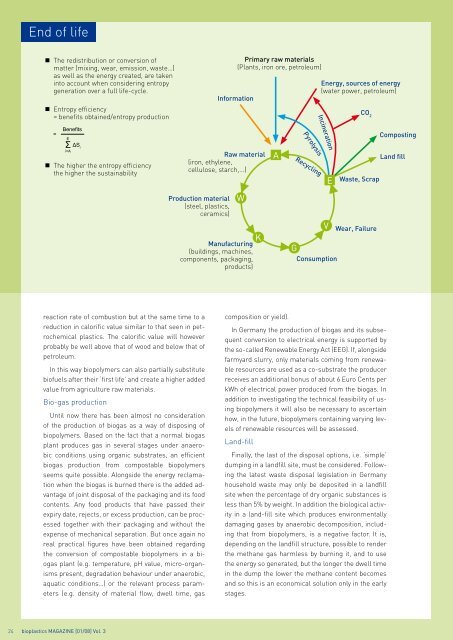01 | 2008
You also want an ePaper? Increase the reach of your titles
YUMPU automatically turns print PDFs into web optimized ePapers that Google loves.
End of life<br />
• The redistribution or conversion of<br />
matter (mixing, wear, emission, waste…)<br />
as well as the energy created, are taken<br />
into account when considering entropy<br />
generation over a full life-cycle.<br />
• Entropy efficiency<br />
= benefits obtained/entropy production<br />
Information<br />
Primary raw materials<br />
(Plants, iron ore, petroleum)<br />
Energy, sources of energy<br />
(water power, petroleum)<br />
CO 2<br />
=<br />
Benefits<br />
E<br />
Σ ΔS i<br />
i=A<br />
• The higher the entropy efficiency<br />
the higher the sustainability<br />
Raw material<br />
(iron, ethylene,<br />
cellulose, starch,...)<br />
A<br />
Pyrolysis<br />
Recycling<br />
Incineration<br />
E<br />
Waste, Scrap<br />
Composting<br />
Land fill<br />
Production material<br />
(steel, plastics,<br />
ceramics)<br />
W<br />
Manufacturing<br />
(buildings, machines,<br />
components, packaging,<br />
products)<br />
K<br />
V<br />
G<br />
Consumption<br />
Wear, Failure<br />
reaction rate of combustion but at the same time to a<br />
reduction in calorific value similar to that seen in petrochemical<br />
plastics. The calorific value will however<br />
probably be well above that of wood and below that of<br />
petroleum.<br />
In this way biopolymers can also partially substitute<br />
biofuels after their ‘first life’ and create a higher added<br />
value from agriculture raw materials.<br />
Bio-gas production<br />
Until now there has been almost no consideration<br />
of the production of biogas as a way of disposing of<br />
biopolymers. Based on the fact that a normal biogas<br />
plant produces gas in several stages under anaerobic<br />
conditions using organic substrates, an efficient<br />
biogas production from compostable biopolymers<br />
seems quite possible. Alongside the energy reclamation<br />
when the biogas is burned there is the added advantage<br />
of joint disposal of the packaging and its food<br />
contents. Any food products that have passed their<br />
expiry date, rejects, or excess production, can be processed<br />
together with their packaging and without the<br />
expense of mechanical separation. But once again no<br />
real practical figures have been obtained regarding<br />
the conversion of compostable biopolymers in a biogas<br />
plant (e.g. temperature, pH value, micro-organisms<br />
present, degradation behaviour under anaerobic,<br />
aquatic conditions…) or the relevant process parameters<br />
(e.g. density of material flow, dwell time, gas<br />
composition or yield).<br />
In Germany the production of biogas and its subsequent<br />
conversion to electrical energy is supported by<br />
the so-called Renewable Energy Act (EEG). If, alongside<br />
farmyard slurry, only materials coming from renewable<br />
resources are used as a co-substrate the producer<br />
receives an additional bonus of about 6 Euro Cents per<br />
kWh of electrical power produced from the biogas. In<br />
addition to investigating the technical feasibility of using<br />
biopolymers it will also be necessary to ascertain<br />
how, in the future, biopolymers containing varying levels<br />
of renewable resources will be assessed.<br />
Land-fill<br />
Finally, the last of the disposal options, i.e. ‘simple’<br />
dumping in a landfill site, must be considered. Following<br />
the latest waste disposal legislation in Germany<br />
household waste may only be deposited in a landfill<br />
site when the percentage of dry organic substances is<br />
less than 5% by weight. In addition the biological activity<br />
in a land-fill site which produces environmentally<br />
damaging gases by anaerobic decomposition, including<br />
that from biopolymers, is a negative factor. It is,<br />
depending on the landfill structure, possible to render<br />
the methane gas harmless by burning it, and to use<br />
the energy so generated, but the longer the dwell time<br />
in the dump the lower the methane content becomes<br />
and so this is an economical solution only in the early<br />
stages.<br />
24 bioplastics MAGAZINE [<strong>01</strong>/08] Vol. 3


















